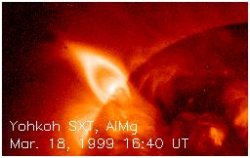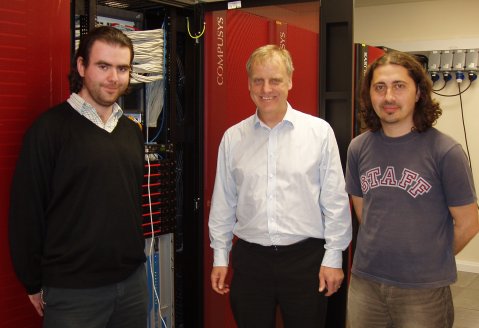The mathematics of the sun
Scientists have created a numerical model of the sun, capable of showing the formation of flares, jets and mass ejections it sends hurtling toward Earth.
 The team of researchers at the University of St Andrews have created a model – the first of its kind – which investigates the rising motion of magnetic fields, from inside the sun to its outer atmosphere. The model shows spectacular structures emerging within the sun before they ever become visible.
The team of researchers at the University of St Andrews have created a model – the first of its kind – which investigates the rising motion of magnetic fields, from inside the sun to its outer atmosphere. The model shows spectacular structures emerging within the sun before they ever become visible.
Dr Vasilis Archontis, Professor Alan Hood, and Dr Chris Brady, of the University’s School of Mathematics & Statistics, are investigating the suspected links between magnetic fields and the creation of solar filaments, flares and plasma ejections. Recent observations have revealed many properties of these events, but the knowledge of the physics behind their formation and evolution is still limited.
The model created by the St Andrews team has successfully produced phenomena consistent with real-life observations, which means that it is good enough to investigate real solar behaviour.

The researchers said, “Solar flares and Coronal Mass Ejections blast high-energy gamma-rays and x-rays toward the Earth, which can disrupt GPS and navigational signals. Also, eruptions of structures called plasmoids can turn into large-scale explosions of high-speed plasma that may set off geomagnetic storms on Earth. The Sun also regularly sends x-ray jets hurtling into outer space.
“All these phenomena, it turns out, are related, and caused by relatively simple natural processes that take place out of view, beneath the Sun¿s visible surface. What we have created is a numerical model of magnetic fields which interact as they rise from the deep solar interior. This model is good enough to produce the above-mentioned dramatic events occurring in the Sun.”
“Our model is interesting not only because it shows how a series of striking events are related to the emergence and interaction of solar magnetic fields, but it can also be used to generate the initial conditions that other researchers have used in their previous models,” they continued.
The team now plans to create larger and more detailed models, which they hope will help understand explain a wide range of solar and astrophysical phenomena.
The team’s work appears on the cover of the April IV issue of the journal Astronomy and Astrophysics.
ENDS
NOTE TO EDITORS:
THE RESEARCHERS ARE AVAILABLE FOR INTERVIEW:
Vasilis Archontis: 01334 461648, [email protected]
Alan Hood: 01334 463710, [email protected]
Chris Brady: 01334 463750, [email protected]
Issued by Press Office, University of St Andrews
Contact Gayle Cook, Press Officer on 01334 467227 / 462529, mobile 07900 050 103, or email [email protected]
Ref: Mathematics of the sun 210507
View the latest University press releases at http://www.st-andrews.ac.uk
Category Research